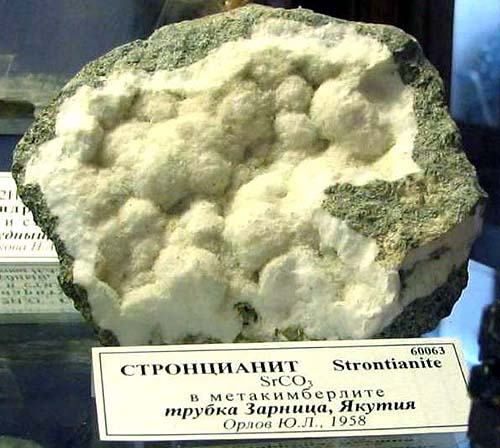Carbonates: Strontianite
 Diagnostic card.
Diagnostic card.
Sr CO 3
Diamond orthogonality
Hardness 3,5
Specific weight 3,7
Cleavage is perfect
Semi-fracture fracture
Color is colorless, colored
Color in powder white
Glitter glass

Strontianite is strontium carbonate. Glitter is glass, zhirnovaty. Transparent to translucent. Colors: grayish-white, yellowish; There are water-transparent colorless differences. The line is white. Fracture shell. It's fragile. Cleavage is perfect. Stains flames in carmine-red color. It is formed in cracks in limestones and marls. Crystals (rhombic syngony) are bipyramidal, acicular, and also radiant or fibrous aggregates. Places of distribution: Harz (Germany, Germany), Tyrol (Austria), Scotland.
Sometimes it was called strontiantite. It crystallizes in the form of acicular crystals, rarely solitary. More often it is bundle-shaped and sheaf-like aggregates; Even more common masses of dense or granular composition. The mineral is brittle, easily separates along cleavage planes parallel to the faces of the vertical prism. Basically strontianite is white in color, but its coloration may have a pinkish, gray or green tinge; In powder it is white. The mineral is transparent or translucent, the glitter is glassy.
Chemical composition. Strontium oxide (SrO) is 70.2%, carbon dioxide (CO2) is 29.8%. Form of crystals. Dipyramids, spear and needle crystals. Crystal structure. Lattice of the aragonite type. Class of symmetry. Rhombo-bipyramidal - mmm. Cleavage. Occurs rarely, in these cases, distinct by (110). Aggregates. Dense, fibrous, radiant.
Diagnostic signs.
Under the influence of ultraviolet rays, strontianite can fluoresce with blue light. When heated, the thermoluminescence property is sometimes found. Dissolves with effervescence in cold dilute hydrochloric acid. The mineral powder placed in the flame stains it in a carmine-red color, indicating the presence of strontium. With strong calcination, the mineral swells, becoming like a head of cauliflower, brightly shining, staining the flame in a carmine-red color. Behavior in acids. Easily soluble with effervescence.
Origin.
Strontianite has a typically hydrothermal origin. It is formed during the crystallization of residual fluids formed during the formation of granites and pegmatites. When these fluids penetrate into the cracks of surrounding rocks and fill them, then as a result of cooling, hydrothermal veins are formed, in which strontianite is associated with other typical vein minerals, such as calcite, celestite, barite, zinc blende, galena, etc.
Place of Birth.
In Stroncian (Scotland), the mineral is found in veins in association with galena and barite. Beautiful crystals are found in Australia and Freiberg (Germany). In Italy, celestite is noted in insignificant quantities in the barite mine near Porto-Serezio (province of Varese). Large deposits developed industrially are known in Westphalia and Harz (Germany), Spain, Mexico and Strontiain Hills in California (USA).
Application.
Strontianite is ore on strontium. This element is used in pyrotechnics (because of its ability to color the flame in different colors), in the sugar industry and in the production of special glasses.

Strontianite in metacimberite. Pipe Zarnitsa, Yakutia, Russia.

Strontianite with bastnesite and chlorite for burbankite. Mountain Lake, Aldan, Yakutia, Russia. Photo: © А.А. Evseev.
- Ghetchellit - "New Almaden blend" - arsenide and antimony sulfide (modern sulfosol)
- Antimony is a toxic metal (semimetal) , widely used in metallurgy, medicine and engineering
- Zirconium - a rare and undiscovered metal and the most dangerous precious stone in oxide and salt
- Gold - yellow dangerous and poisonous metal of modern accurate digital and cable technologies
- Sulfur is a golden-yellow toxic substance and a sign of active volcanic activity
- Cadmium is an undisputed toxic silvery metal unknown to a wide range of people
- Lead - a toxic gray imitator of metallic silver and toxic metal blende
- Arsenic is a classic poison of medieval and modern poisoners and medicine in medicine
Poisonous and radioactive dangerous stones and minerals
** - poisonous stones and minerals (mandatory check in the chemical laboratory + explicit indication of toxicity)
** - radioactive stones and minerals (mandatory check on the standard dosimeter + ban on open sales in case of radioactivity exceeding 24 milli / g / h + additional measures of population protection)
Catalog of minerals and semi-precious stones of the world by groups
** - poisonous stones and minerals
** - radioactive stones and minerals


Comments
When commenting on, remember that the content and tone of your message can hurt the feelings of real people, show respect and tolerance to your interlocutors even if you do not share their opinion, your behavior in the conditions of freedom of expression and anonymity provided by the Internet, changes Not only virtual, but also the real world. All comments are hidden from the index, spam is controlled.